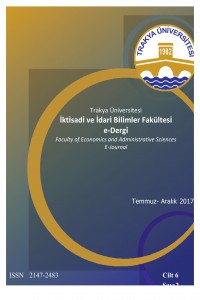Öz
Biyolojik
çeşitlilik çevre sorunlarının önemli bileşenlerinden biridir, fakat son birkaç on
yılda görülen biyolojik çeşitlilikteki dramatik azalma insanlığın geleceğini
tehdit eder duruma gelmiştir. Bu bağlamda, çevre sorunlarının kavşak
noktasında, kilit öneme sahip bir sorun olan biyolojik çeşitlilik kaybı, bu
çalışmada diğer sorunlarla ilişkisi bağlamında, fakat özellikle bir sağlık
sorunu olarak ele alınacaktır. Geleneksel toplumlarda bitki ve hayvan türleri
doğrudan ve dolaylı insan sağlığı için önemli hizmetlerde bulunmuştur. Bugün de
modern tıbbi araştırmalar ve eczacılık sektörü için büyük imkanlar sunan
biyolojik çeşitlilik gelecekte de tıp ve sağlık alanının ana unsurlarından biri
olacaktır. Bu nedenle biyolojik çeşitlilik bir tıp ve sağlık sorunu,
dolayısıyla insanoğlunun varoluş sorunu olarak ele alınarak analiz edilecektir.
Bu çalışmada, biyolojik çeşitliliğin alt alanlarında yapılan monografik
araştırmalar ve raporların bulguları üzerinden biyolojik çeşitlilik ve sağlık
sorunu arasındaki ilişkiler saptanmaya, biyolojik çeşitlilik kaybının insan
sağlığı alanında yaratacağı muhtemel sonuçlar belirlenmeye çalışılacaktır.
Anahtar Kelimeler
Çevre türlerin kaybı biyolojik çeşitlilik ve sağlık biyolojik çeşitlilik ve eczacılık
Kaynakça
- Cordell, Geoffrey A. (2000). “Biodiversity and Drug Discovery – A Symbiotic Relationship”, Phytochemistry, 55: 463-480
- Duke, James A.; Ayensu, Edward S., (1985). Medicinal Plants of China, vol. 1, Research PublAlgonac, MI.
- Endangered Species International, (2015). Why Protect Biodiversity and Save Endangered Species?, http://www.endangeredspeciesinternational.org/overview4.html (26.06.2015)
- IUCN, (2015). Conservation Successes Overshadowed by More Species Declines-IUCN Red List Update, http//www.iucn.org/news_hompage/?21561/Conservation-successes-overshadoved-by-more-speciesdeclines—IUCN-Red-List-update (25.06.2015)
- Jones, Kate E., Patel, Nikkita G., Levy, Mark A., Storeygard, Adam, Balk, Deborah, Gittleman, John L. & Daszak, Peter (2008). “Global Trends in Emerging Infectious Diseases”, Nature 45: 990-994.
- Kamboj, Ved P. (2000). “Herbal Medicine”, Current Science., 78: 35-39.
- Keesing, Felicia; Holt, Robert D. & Ostfeld, Richard S. (2006). “Effects of Species Diversity on Disease Risk”, Ecology Letters 9: 485-498.
- Munoz-Blanco, Javier; Von Essen, Mairus & Hoffmann, Alexander (2015). “Biodiversity for the Present and Future of Humanity: A Suggestion for the SDG Process”, SDG.earthsystemgovernance.org Discussion Paper. Lund: Earth System Governance Project.
- Myers, Norman (1993). “Biodiversity and the Precautionary Principle”, Ambio, Vol.22, No. 2/3: 74-79.
- Myers, Norman (1996). Ultimate Security: The Environmental Basis of Political Stability, Island Press, Washington, DC.
- Natural History Museum, (2015)..Why Conserve Biodiversity?, http://internt.nhm.ac.uk/nature-online/biodiversity/why-conserve-biodiversity/index.html (25.06.2015).
- Rich, Nathaniel (2012). “Can a Jellyfish Unlock the Secret of Immortality?”, The New York Times Magazine, November 28, 2012.
- Samant, Sher S. & Dhar, Uppeandra (1997), “Diversity Endemism and Economic Potential of Wild Edible Plants of Indian Himalaya”, International Journal of Sustainable Development and World Ecology, Volume 4, Issue 3: 179-191.
- Searle, Catherine L.; Biga, L.indsay M.; Spatafora, Joseph W. & Blaustein, Andrew R. (2011). “A Dilution Effect in the Emerging Amphibian Pathogen Batrachocytrium Dendrobatidis”, Proceedings of the National Academy of Sciences of the United States of America 108: 16322-16326.
- Tepe, Bektaş; Sökmen, Münevver; Akpulat, H. Aşkın ve Sökmen, Atalay (2006). “Screening of the Antioxidant Potentials of Six Salvia Species from Turkey”, Food Chemistry, Volume 95, Issue 2, March 2006: 200-204.
- UNESCO (2012). Rio Ocean Declaration, www.unesco.org/new/fileadmin/MULTIMEDYA/HQ/SC/pdf / Pdf_Rio_Ocean_Declaration_2012.pdf (23.06.2015)
- UNESCO (2015). Blueprint for the Future We Want, http://www.unesco.org/new/en/natural-sciences/ioc-oceans/priority-areas/rio-20-ocean/blueprint-for-the-future-we-want/ (23.06.2015)
- UNESCO, (2015). Facts and Figures on Marine Biodiversity, http://www.unesco.org/new/en/natural-sciences/ioc-oceans/priority-areas/rio-20-ocean/blueprint-for-the-future-we-want/marine-biodiversity/facts-and-figures(23.06.2015 )
- United Nations (1992). Convention on Biological Diversity, https://www.cbd.int/doc/legal/cbd-en.pdf (01.07.2015)
- United Nations Development Programme (2012). The Future We Want: Biodiversity and Ecosystems – Driving Sustainable Development. United Nations Development Programme Biodiversity and Ecosystems Global Framework 2012-2020. New York.
- Vidyarthi, Shalini; Samant, Sher S. & Sharma, Pankaj (2013). “Traditional and Indigenous Uses of medicinal Plants by Local Residents in Himachal Pradesh, North Western Himalaya, India”, International Journal of Biodiversity Science, Ecosystem Services & Management, Volume 9, Issue 3: 185 – 200.
- Wilson, Edward O. (1988). “The Current State of Biological Diversity”, in E. O. Wilson (ed.), Biodiversity (pp. 3-18), Washington DC: The National Academies Press.
- World Wide Fund for Nature (WWF), Living Planet Report 2014, World Wide Fund for Nature, Gland, Switzerland
- Yule, Jeffrey V.; Fournier, Robert J. & Hindmarsh, Patrick I. (2013). “Biodiversity, Extinction, and Humanity’s Future: The Ecological and Evolutionary Consequences of Human Population and Resource Use”, Humanities, 2, pp. 147-159.
Ayrıntılar
| Bölüm | Araştırma Makaleleri |
|---|---|
| Yazarlar | |
| Yayımlanma Tarihi | 8 Ocak 2018 |
| Gönderilme Tarihi | 25 Ağustos 2017 |
| Yayımlandığı Sayı | Yıl 2017 Cilt: 6 Sayı: 2 |
 Bu eser Creative Commons Atıf 4.0 Uluslararası Lisansı ile lisanslanmıştır.
Bu eser Creative Commons Atıf 4.0 Uluslararası Lisansı ile lisanslanmıştır. 


